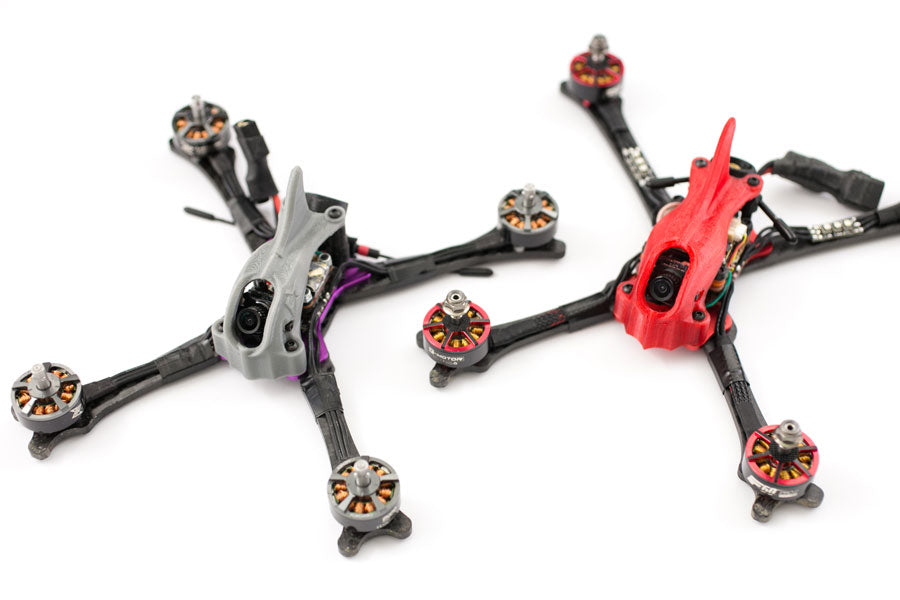
20x20 Components are the Future: 30x30 is Dead
Is 30×30 dead? With the current advancement of 20x20mm components, is there a reason to still use 30×30?
Just 6 months ago it was hard to find a reliable 20×20 components. The first good 20×20 stack was the EMAX MINI Mag 2. Still a great stack but the M2 hardware is a huge pain in the ass. The flight controller is only an F4 with 1 free UART. Sounds ok until you look at the new F7 flight controllers that have 5 free UARTS! The 35A ESC can take power up to 6s but according to the specs it’s limited to 1700kv motors.
Using 20×20 components over 30×30 has many advantages.
- Weight on electronics – Just on the electronics alone using a 20×20 stack will save around 15g.
- Frame weight – if using a frame that’s 20×20 only, less room is needed for the stack thus the frame will be smaller, standoffs can be closer to the center so the arms can be shorter. Overall less frame material will be needed saving weight.
- Price – very often 20×20 components cost less than the 30×30 alternative
- Features – usually the 20×20 will equal or surpass the 30×30 in terms of features
- Size – duh, they are smaller
20×20 vs 30×30 Parts Comparison
First lets compare ESCs of similar specs. The Aikon AK32 is one of the most reliable ESCs on the market today. It comes in two versions, 30×30 and 20×20.
Winner 20×20: As you can see the specs are nearly identical. Both are 35/45A, BLHELI32 and take up to 6s voltages. The 20×20 version is much smaller, weighs 10g less and costs $7 less.
FlightOne
On the Flightone side the winner is not so clear.
Winner 30×30: If you compare the Bolt32 to the Spark32, the specs are nearly identical. Tricky thing is that the Spark32 has 20×20 mount holes but it’s actually bigger than a 30×30! Compared to the Spark V2 the Bolt32 has better specs.
Betaflight flight controller comparison
Winner 20×20: Both of these flight controller’s specs are awesome and long! For the sake of this comparison we’ll just focus on the main specs. The LUX F7 has more bells and whistles but the Talon F7 can hold it’s own on the main specs.
Helio Siblings
Winner 20×20: This one is easy. The Helio mini has all the same features of the full size Helio, just shrunk down and weighs half as much.
Build Comparison
Comparing two builds, PROton (red) is 30×30 and the Neutron is 20×20 (grey) both in hybrid configuration (SX up front and 6″ X in rear).

PROton (red) 301g
- PROton hybrid
- Tmotor F40 1750kv 31g
- FlightOne Bolt32 ESC 15.5g
- FlightOne RevoltOSD 6g
- TBS UNIFY RACE VTX 7g
Neutron (grey) 275g
- Neutron hybrid
- Lumenier ZIP POPO 32g
- AK32 20×20 10g
- Talon F7 4.3g
- TBS PRO32 Nano VTX 1g (check out the POST)
On average a 20×20 build will be at least 20g lighter than a similar 30×30 build.
I can’t think of a single reason to use 30×30 over 20×20.
If you haven’t built a 20×20 quad yet, do it! They are so much more nimble and can turn on a dime. Check out some 20×20 goodies and build yourself a rocket.
If you found this post helpful, it would be super cool if you purchased the components from my store or purchase items from my Amazon links. These posts are expensive and take a loooong time to make so the purchases make it possible for me to keep making them. Thanks in advance, I greatly appreciate it 🙂
